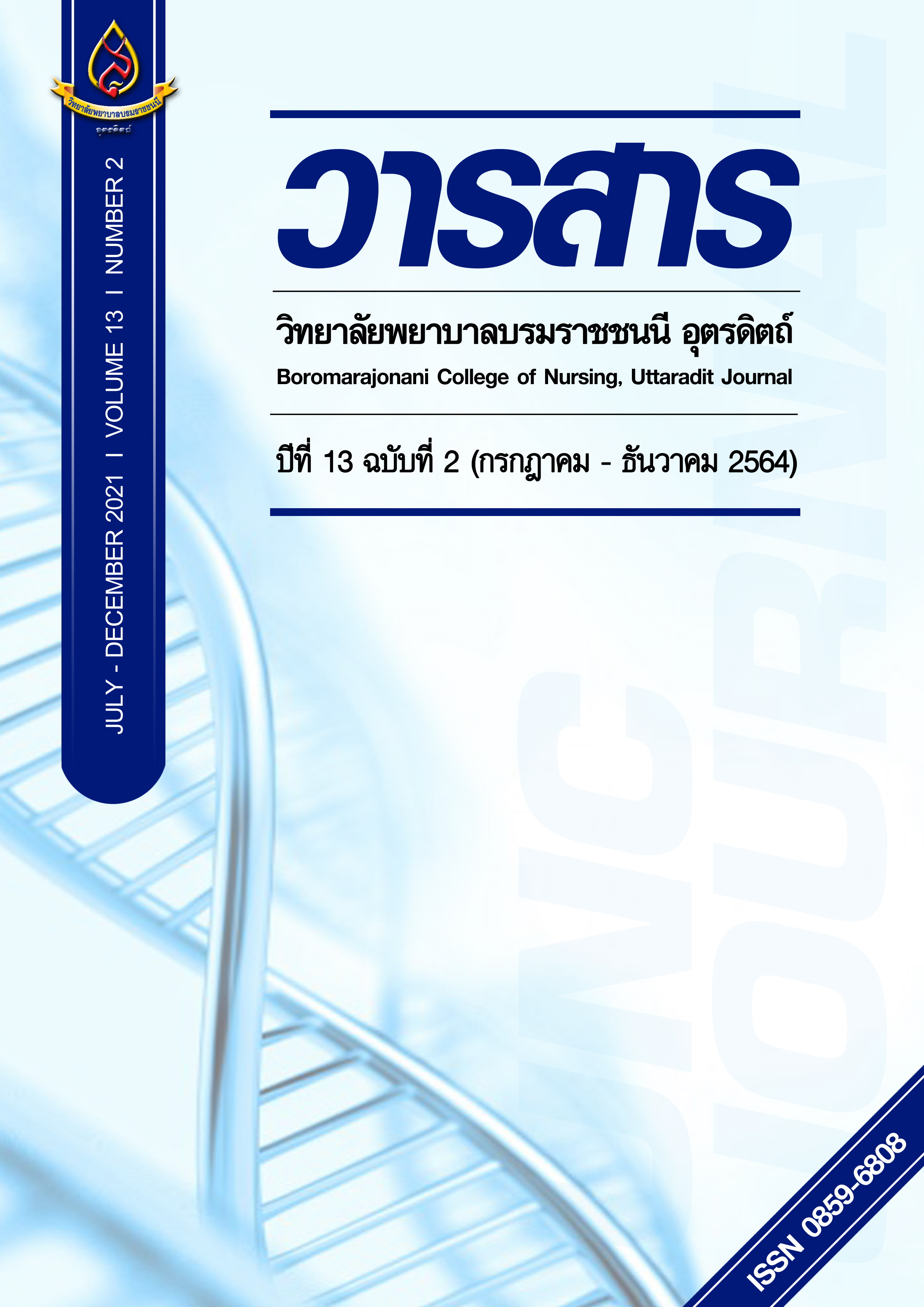ผลของโปรแกรม ผลของโปรแกรมการจัดการตนเองต่อพฤติกรรมการดูแลตนเองและการควบคุม ความดันโลหิตของผู้ป่วยความดันโลหิตสูงที่ควบคุมไม่ได้
Main Article Content
บทคัดย่อ
การวิจัยเชิงกึ่งทดลองชนิดกลุ่มเดียววัดผลก่อนและหลังการทดลอง เพื่อศึกษาผลของโปรแกรมการจัดการตนเองตามแนวคิดการจัดการตนเองของเคนเฟอร์และแกลิค (Kanfer & Gaelick, 1991) มาพัฒนาโปรแกรมที่ส่งผลต่อพฤติกรรมการดูแลตนเอง ได้แก่ การรับประทานอาหาร การออกกำลังกาย การจัดการกับความเครียด การไม่ดื่มเครื่องดื่มที่มีแอลกอฮอล์ การไม่สูบบุหรี่ และการรับประทานยาตามแผนการรักษาอย่างต่อเนื่อง กลุ่มตัวอย่าง คือ ผู้ป่วยความดันโลหิตสูงที่ควบคุมความดันโลหิตไม่ได้ จำนวน 30 คน ที่มารับบริการ ณ โรงพยาบาลส่งเสริมสุขภาพตำบลบ้านแม่ผาแหน ตำบลออนใต้ อำเภอสันกำแพง จังหวัดเชียงใหม่ ระหว่างเดือนตุลาคม 2563 ถึงเดือนมีนาคม 2564 เครื่องมือที่ใช้ประกอบด้วย แบบสอบถามพฤติกรรมของผู้ป่วย วิเคราะห์ข้อมูลโดยใช้ค่าความถี่และร้อยละ ค่าเฉลี่ย ส่วนเบี่ยงเบนมาตรฐาน และ สถิติที (t-test dependent)
ผลการศึกษาพบว่า 1) ผู้ป่วยความดันโลหิตสูงภายหลังได้รับโปรแกรมมีค่าเฉลี่ยของพฤติกรรมการดูแลตนเองสูงกว่าก่อนได้รับโปรแกรม อย่างมีนัยสําคัญทางสถิติที่ระดับ .05 2) ผู้ป่วยความดันโลหิตสูงภายหลังได้รับโปรแกรมมีค่าเฉลี่ยความดันโลหิตต่ำกว่าก่อนได้รับโปรแกรมอย่างมีนัยสําคัญทางสถิติที่ระดับ .05 แสดงให้เห็นถึงโปรแกรมการจัดการตนเองสามารถปรับเปลี่ยนพฤติกรรมการดูแลตนเองและลดความดันโลหิตของผู้ป่วยความดันโลหิตสูง
Article Details
บทความหรือข้อคิดเห็นใดใดที่ปรากฏในวารสารวิจัยการพยาบาลและวิทยาศาสตร์สุขภาพ เป็นวรรณกรรมของผู้เขียน ซึ่งบรรณาธิการหรือสมาคมศิษย์เก่า ไม่จำเป็นต้องเห็นด้วย และบทความที่ได้รับการตีพิมพ์เผยแพร่ถือเป็นลิขสิทธิ์ของวารสารวิจัยการพยาบาลและวิทยาศาสตร์สุขภาพ
เอกสารอ้างอิง
Ban Maepahand Sub-District Health Promoting Hospital. (2020). Vascular disease risk group registration report. Chiang Mai. (in Thai).
Chiangmai Provincial Public Health Office. (2020). Performance report based on indicators. Retrieved (2020, November 7). from https://www.chiangmaihealth.go.th/cmpho_web/ (in Thai).
Cohen, J. (1988). Statistical power analysis for behavioral sciences. New York: Academic Press.
Department of Disease Control. (2019). Report of NCDs, diabetes, blood pressure situations high and associated risk factors 2019. Bangkok: Aukson Graphic and design. (in Thai).
Division of Non Communicable Diseases. (2016). Modification course Health Behaviors for the Nurse, Case Manager, Chronic Disease. Bangkok: Business office Printing House, Military Relief Organization through education Under royal patronage. (in Thai).
Kanfer, F. H., & Gaelick-Buys, L. (1991). Self-management methods. In F. H. Kanfer & A. Goldstein (Eds.), Helping people change: A textbook of methods. NewYork: Pergamon Press.
Prasat Neurological Institute. (2015). Cerebrovascular disease (paralysis, paralysis) guide for citizens. (9th edition) Bangkok: Institute of Neurology.
Sanee, A. (2014). Self management program in chronic diseases. Journal of The Royal Thai Army Nurses, 15(2), 129-134. (in Thai).
Strategy and planning division of Office of the Permanent Secretary Ministry of Public Health. (2019). Public health statistics 2019. Retrieved (2020, November 7). from http://www.thaihypertension.org/hypertensiondetail.php?n_id=44
Thai Hypertension Society. (2019). Thai guidelines on the treatment of hypertension. Bangkok: Trickthink.
Thatsaeng, B., Lasuka, D. & Khampolsiri, T. (2012). Effects of a self-management supporting program on self-management behaviors and blood pressure among elders with hypertension. Nursing Journal, 39 (4), 124 – 137. (in Thai).
Wangtapan, K. (2019). Stroke Prevention Self-management Programme in Patients with uncontrolled Hypertension. (master’s thesis). Bangkok: Huachiew Chalermprakiet University. (in Thai).
World Health Organization (WHO). (2013). A global brief on hypertension Silent killer, global public health crisis. Retrieved (2020, November 7). from
http://www.who.int/cardiovascular_diseases/publications/global_brief_hypertension/en


